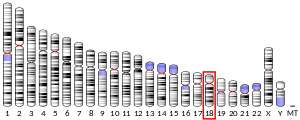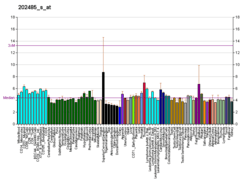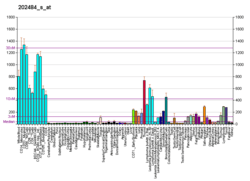Methyl-CpG-binding domain protein 2
Methyl-CpG-binding domain protein 2 is a protein that in humans is encoded by the MBD2 gene.[5][6]
Function
DNA methylation is the major modification of eukaryotic genomes and plays an essential role in mammalian development. Human proteins MECP2, MBD1, MBD2, MBD3, and MBD4 comprise a family of nuclear proteins related by the presence in each of a methyl-CpG-binding domain (MBD). Each of these proteins, with the exception of MBD3, is capable of binding specifically to methylated DNA. MECP2, MBD1, and MBD2 can also repress transcription from methylated gene promoters. The protein encoded by these genes may function as a mediator of the biological consequences of the methylation signal. It is also reported that MBD2 and MBD3 recruit the NuRD complex to regions of DNA depending on their selective binding of methylated CpG sites. Therefore, MBD2/NuRD and MBD3/NuRD define two distinct protein complexes with different biochemical and functional properties.[7]
Interactions
Methyl-CpG-binding domain protein 2 has been shown to interact with:
References
- 1 2 3 GRCh38: Ensembl release 89: ENSG00000134046 - Ensembl, May 2017
- 1 2 3 GRCm38: Ensembl release 89: ENSMUSG00000024513 - Ensembl, May 2017
- ↑ "Human PubMed Reference:".
- ↑ "Mouse PubMed Reference:".
- ↑ Hendrich B, Bird A (November 1998). "Identification and Characterization of a Family of Mammalian Methyl-CpG Binding Proteins". Mol Cell Biol. 18 (11): 6538–47. PMC 109239. PMID 9774669.
- ↑ Hendrich B, Abbott C, McQueen H, Chambers D, Cross S, Bird A (September 1999). "Genomic structure and chromosomal mapping of the murine and human Mbd1, Mbd2, Mbd3, and Mbd4 genes". Mamm Genome. 10 (9): 906–12. doi:10.1007/s003359901112. PMID 10441743.
- ↑ Guezennec, Xavier (2006). "MBD2/NuRD and MBD3/NuRD, Two Distinct Complexes with Different Biochemical and Functional Properties". Molecular and Cellular Biology. 26 (3): 843–851. doi:10.1128/MCB.26.3.843-851.2006. PMC 1347035. PMID 16428440. Retrieved 2018-09-05.
- 1 2 3 Brackertz M, Boeke J, Zhang R, Renkawitz R (October 2002). "Two highly related p66 proteins comprise a new family of potent transcriptional repressors interacting with MBD2 and MBD3". J. Biol. Chem. 277 (43): 40958–66. doi:10.1074/jbc.M207467200. PMID 12183469.
- ↑ Feng Q, Cao R, Xia L, Erdjument-Bromage H, Tempst P, Zhang Y (January 2002). "Identification and functional characterization of the p66/p68 components of the MeCP1 complex". Mol. Cell. Biol. 22 (2): 536–46. doi:10.1128/mcb.22.2.536-546.2002. PMC 139742. PMID 11756549.
- 1 2 Ng HH, Zhang Y, Hendrich B, Johnson CA, Turner BM, Erdjument-Bromage H, Tempst P, Reinberg D, Bird A (September 1999). "MBD2 is a transcriptional repressor belonging to the MeCP1 histone deacetylase complex". Nat. Genet. 23 (1): 58–61. doi:10.1038/12659. PMID 10471499.
- 1 2 3 Zhang Y, Ng HH, Erdjument-Bromage H, Tempst P, Bird A, Reinberg D (August 1999). "Analysis of the NuRD subunits reveals a histone deacetylase core complex and a connection with DNA methylation". Genes Dev. 13 (15): 1924–35. doi:10.1101/gad.13.15.1924. PMC 316920. PMID 10444591.
- ↑ Jiang CL, Jin SG, Pfeifer GP (December 2004). "MBD3L1 is a transcriptional repressor that interacts with methyl-CpG-binding protein 2 (MBD2) and components of the NuRD complex". J. Biol. Chem. 279 (50): 52456–64. doi:10.1074/jbc.M409149200. PMID 15456747.
- ↑ Sekimata M, Takahashi A, Murakami-Sekimata A, Homma Y (November 2001). "Involvement of a novel zinc finger protein, MIZF, in transcriptional repression by interacting with a methyl-CpG-binding protein, MBD2". J. Biol. Chem. 276 (46): 42632–8. doi:10.1074/jbc.M107048200. PMID 11553631.
- ↑ Boeke J, Ammerpohl O, Kegel S, Moehren U, Renkawitz R (November 2000). "The minimal repression domain of MBD2b overlaps with the methyl-CpG-binding domain and binds directly to Sin3A". J. Biol. Chem. 275 (45): 34963–7. doi:10.1074/jbc.M005929200. PMID 10950960.
Further reading
- Scanlan MJ, Chen YT, Williamson B, Gure AO, Stockert E, Gordan JD, Türeci O, Sahin U, Pfreundschuh M, Old LJ (1998). "Characterization of human colon cancer antigens recognized by autologous antibodies". Int. J. Cancer. 76 (5): 652–8. doi:10.1002/(SICI)1097-0215(19980529)76:5<652::AID-IJC7>3.0.CO;2-P. PMID 9610721.
- Zhang Y, LeRoy G, Seelig HP, Lane WS, Reinberg D (1998). "The dermatomyositis-specific autoantigen Mi2 is a component of a complex containing histone deacetylase and nucleosome remodeling activities". Cell. 95 (2): 279–89. doi:10.1016/S0092-8674(00)81758-4. PMID 9790534.
- Tong JK, Hassig CA, Schnitzler GR, Kingston RE, Schreiber SL (1998). "Chromatin deacetylation by an ATP-dependent nucleosome remodelling complex". Nature. 395 (6705): 917–21. doi:10.1038/27699. PMID 9804427.
- Bhattacharya SK, Ramchandani S, Cervoni N, Szyf M (1999). "A mammalian protein with specific demethylase activity for mCpG DNA". Nature. 397 (6720): 579–83. doi:10.1038/17533. PMID 10050851.
- Zhang Y, Ng HH, Erdjument-Bromage H, Tempst P, Bird A, Reinberg D (1999). "Analysis of the NuRD subunits reveals a histone deacetylase core complex and a connection with DNA methylation". Genes Dev. 13 (15): 1924–35. doi:10.1101/gad.13.15.1924. PMC 316920. PMID 10444591.
- Ng HH, Zhang Y, Hendrich B, Johnson CA, Turner BM, Erdjument-Bromage H, Tempst P, Reinberg D, Bird A (1999). "MBD2 is a transcriptional repressor belonging to the MeCP1 histone deacetylase complex". Nat. Genet. 23 (1): 58–61. doi:10.1038/12659. PMID 10471499.
- Tatematsu KI, Yamazaki T, Ishikawa F (2000). "MBD2-MBD3 complex binds to hemi-methylated DNA and forms a complex containing DNMT1 at the replication foci in late S phase". Genes Cells. 5 (8): 677–88. doi:10.1046/j.1365-2443.2000.00359.x. PMID 10947852.
- Boeke J, Ammerpohl O, Kegel S, Moehren U, Renkawitz R (2001). "The minimal repression domain of MBD2b overlaps with the methyl-CpG-binding domain and binds directly to Sin3A". J. Biol. Chem. 275 (45): 34963–7. doi:10.1074/jbc.M005929200. PMID 10950960.
- Humphrey GW, Wang Y, Russanova VR, Hirai T, Qin J, Nakatani Y, Howard BH (2001). "Stable histone deacetylase complexes distinguished by the presence of SANT domain proteins CoREST/kiaa0071 and Mta-L1". J. Biol. Chem. 276 (9): 6817–24. doi:10.1074/jbc.M007372200. PMID 11102443.
- Feng Q, Zhang Y (2001). "The MeCP1 complex represses transcription through preferential binding, remodeling, and deacetylating methylated nucleosomes". Genes Dev. 15 (7): 827–32. doi:10.1101/gad.876201. PMC 312663. PMID 11297506.
- Sekimata M, Takahashi A, Murakami-Sekimata A, Homma Y (2001). "Involvement of a novel zinc finger protein, MIZF, in transcriptional repression by interacting with a methyl-CpG-binding protein, MBD2". J. Biol. Chem. 276 (46): 42632–8. doi:10.1074/jbc.M107048200. PMID 11553631.
- Müller-Tidow C, Kügler K, Diederichs S, Klümpen S, Möller M, Vogt U, Metzger R, Schneider PM, Berdel WE, Serve H (2001). "Loss of expression of HDAC-recruiting methyl-CpG-binding domain proteins in human cancer". Br. J. Cancer. 85 (8): 1168–74. doi:10.1054/bjoc.2001.2041. PMC 2375156. PMID 11710831.
- Feng Q, Cao R, Xia L, Erdjument-Bromage H, Tempst P, Zhang Y (2002). "Identification and Functional Characterization of the p66/p68 Components of the MeCP1 Complex". Mol. Cell. Biol. 22 (2): 536–46. doi:10.1128/MCB.22.2.536-546.2002. PMC 139742. PMID 11756549.
- Bakker J, Lin X, Nelson WG (2002). "Methyl-CpG binding domain protein 2 represses transcription from hypermethylated pi-class glutathione S-transferase gene promoters in hepatocellular carcinoma cells". J. Biol. Chem. 277 (25): 22573–80. doi:10.1074/jbc.M203009200. PMID 11960994.
- Saito M, Ishikawa F (2002). "The mCpG-binding domain of human MBD3 does not bind to mCpG but interacts with NuRD/Mi2 components HDAC1 and MTA2". J. Biol. Chem. 277 (38): 35434–9. doi:10.1074/jbc.M203455200. PMID 12124384.
- Detich N, Theberge J, Szyf M (2002). "Promoter-specific activation and demethylation by MBD2/demethylase". J. Biol. Chem. 277 (39): 35791–4. doi:10.1074/jbc.C200408200. PMID 12177048.
- Brackertz M, Boeke J, Zhang R, Renkawitz R (2002). "Two highly related p66 proteins comprise a new family of potent transcriptional repressors interacting with MBD2 and MBD3". J. Biol. Chem. 277 (43): 40958–66. doi:10.1074/jbc.M207467200. PMID 12183469.
- Krithivas A, Fujimuro M, Weidner M, Young DB, Hayward SD (2002). "Protein Interactions Targeting the Latency-Associated Nuclear Antigen of Kaposi's Sarcoma-Associated Herpesvirus to Cell Chromosomes". J. Virol. 76 (22): 11596–604. doi:10.1128/JVI.76.22.11596-11604.2002. PMC 136775. PMID 12388720.





